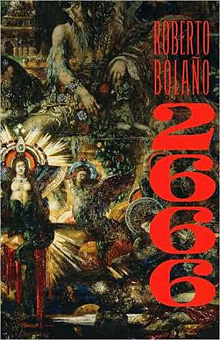
|  |  |  Entertainment | Books | December 2008 Entertainment | Books | December 2008  
Book Review: 2666, by Roberto Bolaño
 Martha Kramer - Political Affairs Martha Kramer - Political Affairs
go to original


| 2666
by Roberto Bolaño
New York, Firrar Strauss and Giroux
Translated by Natasha Wimmer |  |
Women and girls in the fictional Northern Mexico city of Santa Teresa are being murdered. Law enforcement officials, riddled with incompetence and corruption, have few clues and do not seem overly concerned. The women, whom Bolaño catalogs in great detail, sometimes in precise forensic detail, in the novel's massive middle section, are maquiladora workers, students and prostitutes. Many are not even identified before being handed over to the local student hospital or buried in the public grave.

Bolaño's widely acclaimed novel, 2666, is presented in five parts, originally intended as five separate novels. Bolaño didn't make much money as a writer until his novel The Savage Detectives made a huge splash in its 2007 English translation – four years after the Mexican-Chilean author died of liver cancer.

Before his death, Bolaño had asked that 2666 be published as five separate books in order that whatever proceeds he earned from their publication might go to his surviving family. Five years after his death and the publication of the novel in its nearly 900-page entirety, Bolaño's latest work has been recognized as one of the finest novels of 2008.

2666 opens in the European academy. Four scholars begin an investigation into the life of a well-known German novelist. Their search for him and the details of his life leads them to Santa Teresa, Mexico where he was seen last. While there, they encounter a depressed Mexican academic obsessed with a book hanging on his clothes line and a mysterious black car stalking his neighborhood. During their brief visit to the city, the academics learn about the serial murders that have taken the lives of more than 200 women. But for them, the search for a missing German novelist seems more consequential.

The detailed and relentless cataloging of the deaths of hundreds of women in the border city of Santa Teresa in the novel's longest part, titled "The Part About the Crimes," serves as a lens through which readers witness the brutality of a modern society whose fabric has been torn by the exigencies of global capitalism, internal and external migration, and the dehumanization of the characters who people this nightmarish landscape.

At one point the narrator tells of an episode in which two young girls are kidnapped on the street in broad daylight in front of their two younger sisters. The younger sisters run to a neighbor's house, as their own parents are at work in a local maquiladora. The neighbor, who has to go to a public phone because she has none in her house, tries to call the parents at work, but her attempts are met with refusal by the telephone operator at the factory who rejects all "personal" calls. Writes Bolaño:

"Despondent, [the girls' neighbor] went back to her house, to the other neighbor woman and the girls, and for a while the four of them experienced what it was like to be in purgatory, a long, helpless wait, a wait that begins and ends in neglect, a very Latin American experience, as it happened, and all too familiar, something that once you thought about it you realized you experienced daily, minus the despair, minus the shadow of death sweeping over the neighborhood like a flock of vultures and casting its pall, upsetting all routines, leaving everything overturned."

(At this point, it is worth noting that the present action of the novel occurs mainly in the late 1990s, prior to the emergence of the new Latin American left and its bid to shed the dominance of North American imperialism. It is also worth noting that Bolaño's sojourn in Mexico began in the 1970s as a college student after his family fled the Pinochet dictatorship for having supported the socialist government of Salvador Allende.)

Indeed, it is the violence and murder, the brutality of the crimes that upsets the routine of this neglected life. While some individuals on the police force want to solve the murders, the higher-ups are unmoved. When a car linked to a number of the murders turns out to be a make and model of car often used by the older children of the city's elite families, pressure is applied to the police to stop pursuing that lead.

In an earlier part of the novel, an African American journalist named Fate travels to Santa Teresa to cover a boxing match. When he learns about the crimes, his journalistic curiosity is piqued, but his editor refuses to allow him time and resources to write an article on them. At one point, someone tells him, "No one pays attention to these killings, but the secret of the world is hidden in them."

Indeed, the secret of the world. Hidden in the killings of women deemed inconsequential and replaceable is the mystery of power and corruption, labor and life, a struggle for survival that is lost in the anonymous back alleys and basements of the all too real globalized city. |

 |
|  |



